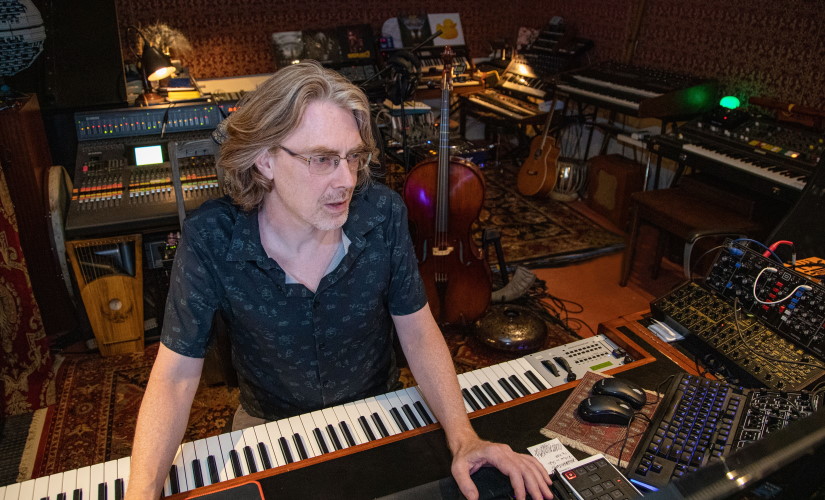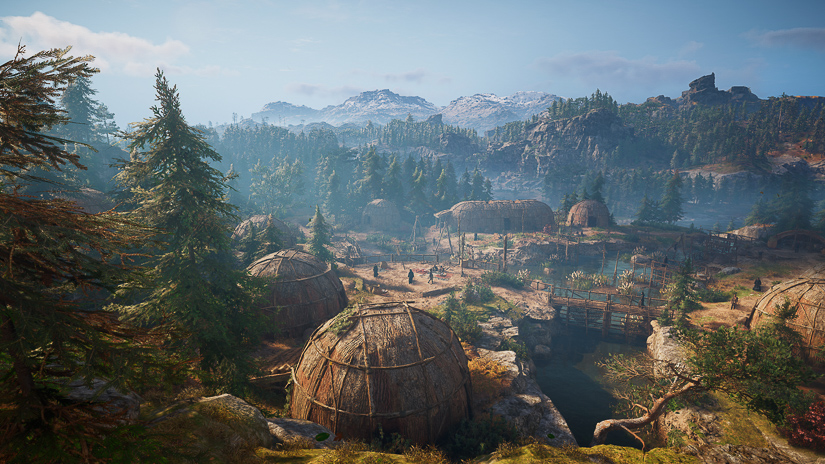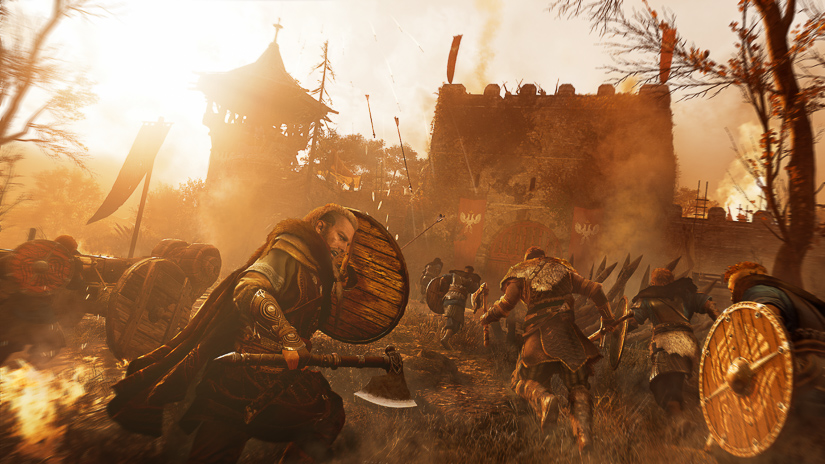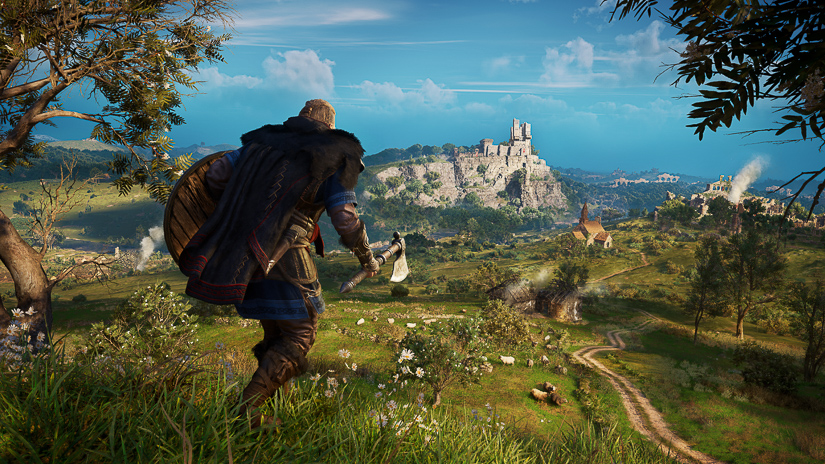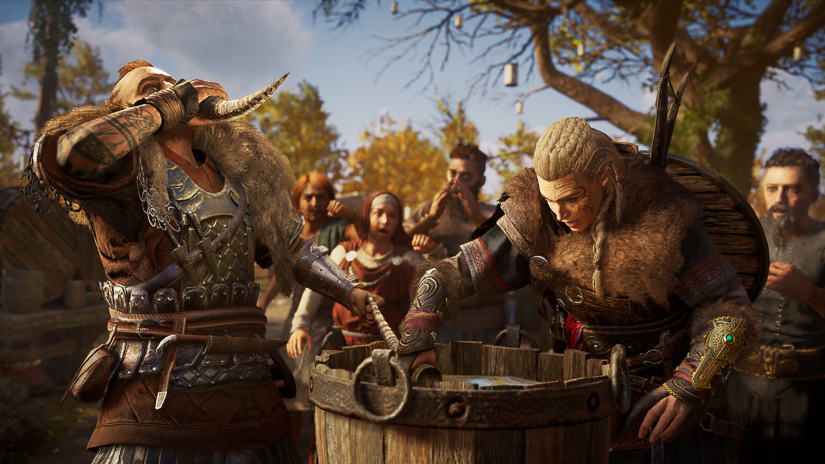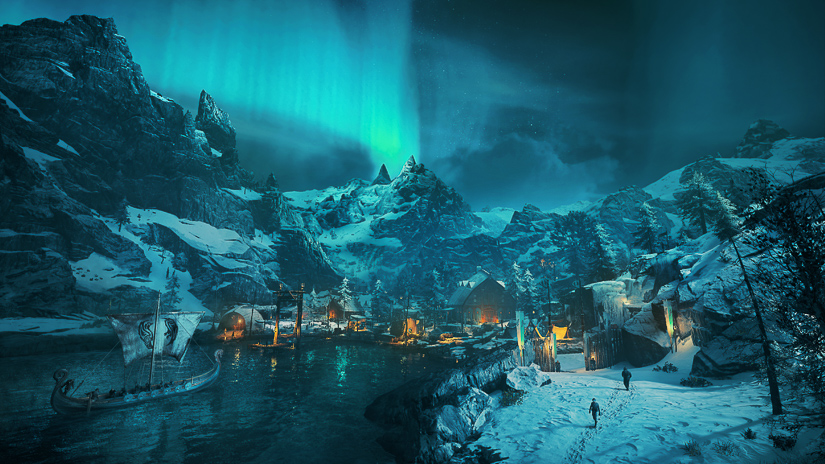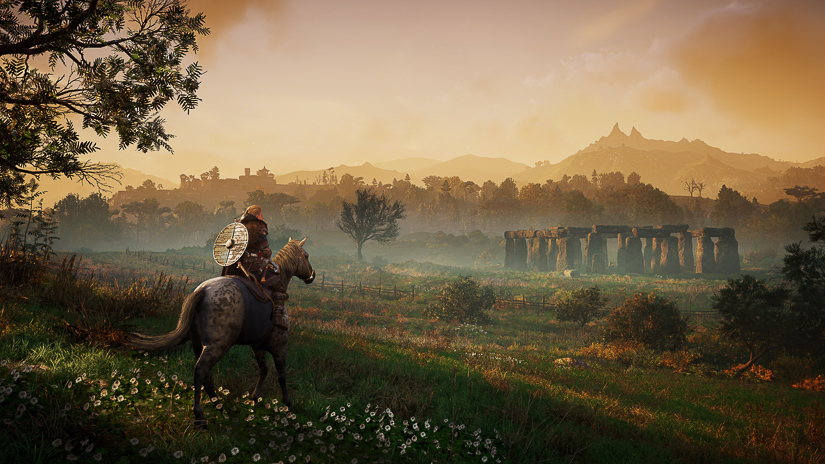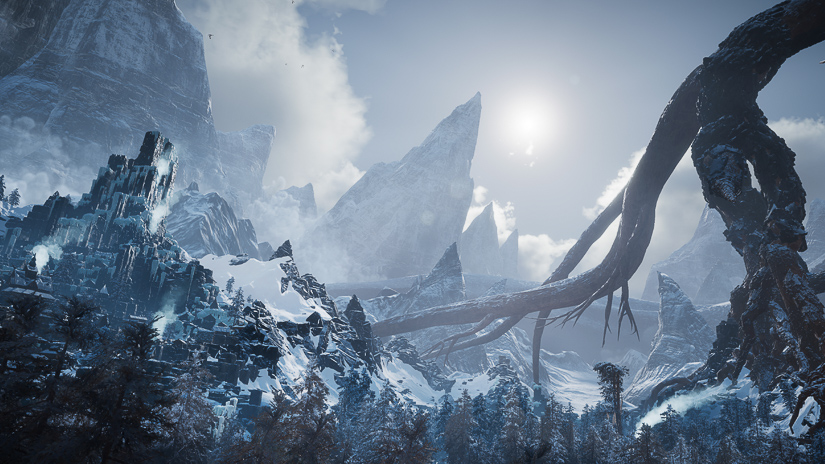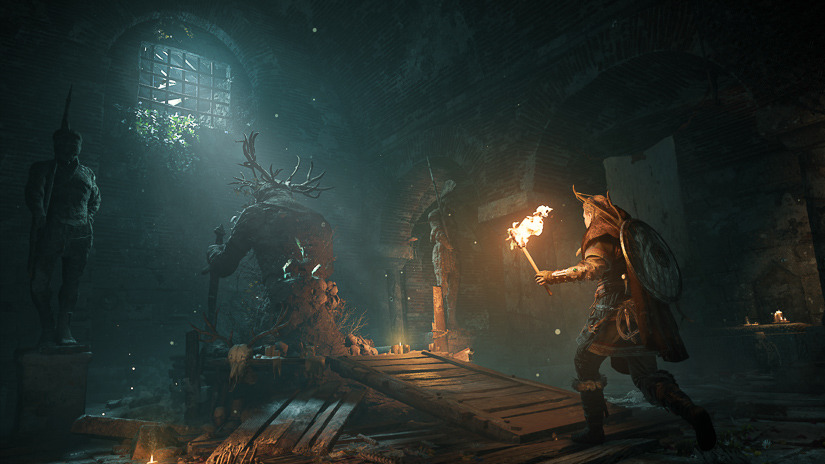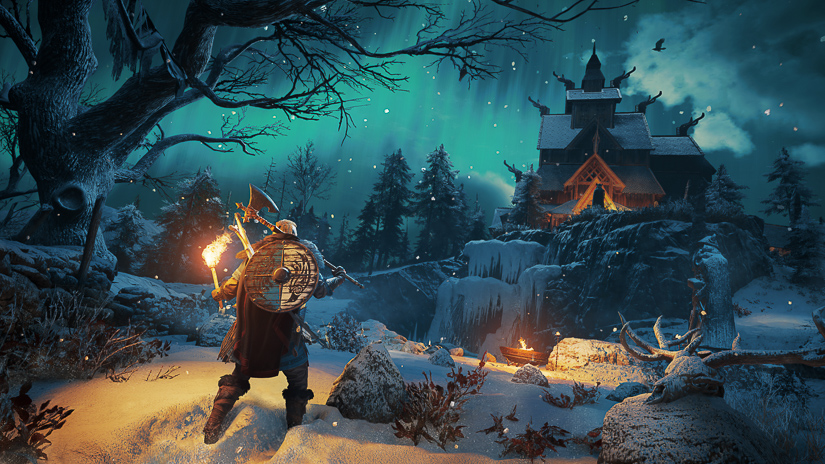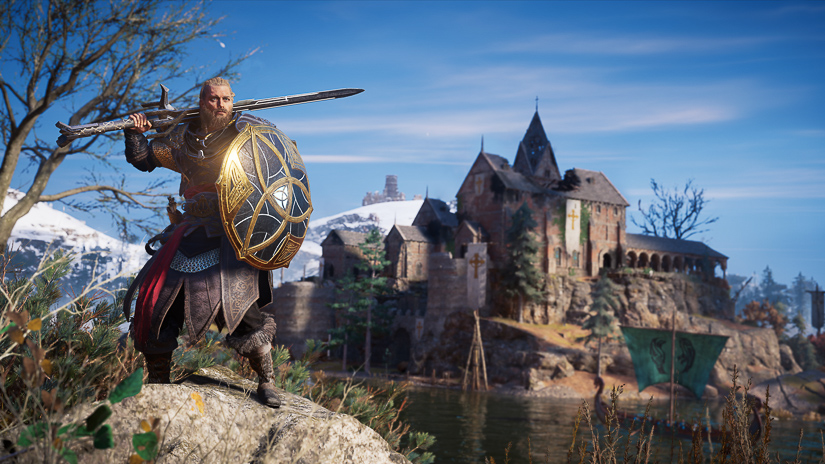Interview by Jennifer Walden, photos courtesy of Ubisoft
Ubisoft’s Assassin’s Creed Valhalla has hit a high note with fans. The Viking-themed RGP is an open-world game, so players are free to explore the environments, the settlements, and make mischief (without resulting to violence, if you choose). In addition to completing main missions and side-missions, players can engage in other activities like drinking contests, dice games, flyting (contest in which insults are exchanged in verse), hunting, fishing, and more.
A Viking-themed game deserves a bold Viking-esk score, and BAFTA-award winning Danish composer Jesper Kyd dug deep into his vocal range to produce the low, throaty singing associated with Nordic folk music. He expanded his musical repertoire to include traditional instruments like the Tagelharpa, Crwth, Rebec, and Morin khuur — which he performs himself in the final tracks.
Kyd collaborated with American composer, producer, and multi-instrumentalist Sarah Schachner (who is no stranger to Assassin’s Creed scores having done several herself: Assassin’s Creed Origins , Unity, and Black Flag) on the main title theme for Valhalla. And they both composed separate exploration music cues for specific areas in-game, cues for stealth and attack, and so on.
Here, Kyd talks about finding the sound of this score, selecting traditional instruments, and how he composed several tracks, like “Out of the North,” “Kingdom of Wessex,” and “Leofirth’s Honor.” Plus, he discusses his choice of analog synthesizers, performing vocals parts, and more!
Assassin’s Creed Valhalla: Launch Trailer | Ubisoft [NA]
You’ve composed several Assassin’s Creed scores — for the original game in 2007, AC II, Brotherhood, Revelations… how does your experience on Valhalla compare to those?
Jesper Kyd (JK): The original Assassin’s Creed was very different. Obviously, being the first Assassin’s Creed game, we worked more on defining what the game sound should be. That was a lot of the focus. That’s where the idea was born of mixing the Animus with acoustic performances in ways that it kind of filters the sound.
And so, just to explain the Animus, it is this device that can tap into your genes and your DNA where you have stored memories from your forefathers. It can sequence those memories and then you get to play those memories as you play through the game. We worked very much on coming up with what that should sound like. It shouldn’t just sound like something that is a more straightforward or traditional score. There are all kinds of things we were doing, filtering the sound and editing and experimenting with the instruments.
So Valhalla was very different from the first Assassin’s Creed, AC II, and Brotherhood. The setting being in the Italian Renaissance, there was a lot there that had to be thought through. We had to establish how to create a modern version of that kind of music.
This time we were exploring these big environments. So that definitely influenced the sound of that score.
In comparison with Valhalla, I think one of the big things I took away from it is how big the game is. It is just vast. And it has a lot of open spaces, forests, fields, mountains and many beautiful vistas. Whereas the other titles I worked on — apart from the first Assassin’s Creed, which also had a lot of open landscapes — most of the games I worked on took place in cities. So there was more platforming around buildings.
This time we were exploring these big environments. So that definitely influenced the sound of that score.
It’s the fifth time I’ve worked with Ubisoft Montreal. I know those people pretty well, and they’re always a pleasure to work with. And I feel they are some of the best at what they do.
And, of course, working with a co-composer Sarah Schachner and songwriter Einar Selvik made it different as well.
Apart from the obvious Viking theme, what are other key visual elements that influenced your approach to the score? You just mentioned being in nature and being outside of the city. Could you elaborate on that?
JK: Yeah. The environment very much influenced the score and one of the first things that Ubisoft told me was how important the environment is in the game. All you have to do is look at the game and you can just tell that a lot of work went into this. So obviously they were looking for something authentic to match that environment.
The environments took center stage and the storyline came in after we started working.
So that also made it different because with games like Assassin’s Creed 2, of course, the Renaissance was important, but the storyline was very important as well in Assassin’s Creed Valhalla. The environments took center stage and the storyline came in after we started working. First, we needed to get the sound of what these environments were going to sound like before we could start adding the story. There was a lot of work put into how this should actually sound.
A lot of Viking music tends to be dark and have these dark pulses going through it. That’s how I thought of Viking music. So the first music cue I sent was way too dark. And not that there’s no dark music in the game, but we really wanted to start with what the environment sounded like — not when you are engaged in combat or when you are engaged in a mission, but what it just sounds like when you’re exploring these environments without being in danger. I made them more ethereal and more uplifting.
That was interesting to find a Viking sound that has that kind of sound to it. That’s a lot of what I worked on.
Let’s talk about your collaboration with Ubisoft Montreal’s audio director Aldo Sampaio and music supervisor Simon Landry. What were their goals for the score and how it related to the sound of the game overall?
JK: Authenticity was definitely number one. I was told early on that we’re not looking for an orchestral soundtrack. The environment needs to really influence the actual sound, not just the melodies but the very DNA of the music.
I realized pretty early on that I was going to have to acquire a lot of ancient instruments, such as Tagelharpa. I got a Tagelharpa Cello, which is a really big version of the Tagelharpa. Other instruments were more inspired by Celtic music, like the Crwth and the Rebec. I use a Morin khuur, which is a Mongolian cello, as well as a regular cello, metal drums, all kinds of things in there.
I realized pretty early on that I was going to have to acquire a lot of ancient instruments, such as Tagelharpa.
Not all of these instruments were around at the time… some of them were not, but that’s okay as long as when I play them, they feel like they fit the world. That is the most important thing.
And so, I got these instruments and I needed to figure out how to compose for them because I don’t know these instruments. So I started playing them and after playing them a lot, I figured, I’m just going to perform them myself because this is just so much fun. And so I was introduced to a world of string instruments and suddenly found myself playing all these instruments and spending all this time performing and tuning and having bleeding fingers and all these things were quite new to me.
I had performed some instruments in the past but on this one I pretty much perform everything myself, except maybe a couple of tracks that had an acoustic guitar in it for a “Kingdom of Wessex.” I had a good friend of mine perform that guitar. So that was pretty much the beginning of the project, realizing I’m not going to be able to achieve the vision I have if I don’t play these instruments myself.
It’s such an interesting palette of instruments that you found. How did you learn to play them? Did you find someone to teach you? Or, did you watch some YouTube videos? Did you learn to play them properly or just feel your way around them?
JK: Yes to the last one; no to all the other ones.
I didn’t want to learn how to play them properly…I want the performance to be rugged, to be rough around the edges…
So I didn’t want to learn how to play them properly. I wanted it to be a more spontaneous thing — the thought being that I want the performance to be rugged, to be rough around the edges, to have some kind of Viking playing them. Not to say that people back then couldn’t be great performers on whatever instruments were around. I felt it was important to get more of an organic performance.
But sometimes I do need a beautiful performance and so that’s when I rely on the soloists I work with. But for the majority of this, I felt like a more organic, rugged performance was the way to go.
So I just played them — taught myself, I guess — and just played and played and played until I felt like I was starting to get a good handle on it.
What about percussion? What did you choose for percussion for these tracks?
JK: There’s a lot of different percussion instruments, the frame drum being one of the key percussion instruments I used in all kinds of different sizes.
I used some unusual percussion instruments, like the spring drum. And I also used some Indian percussion.
I worked with two different percussionists and then I also did a lot of it myself. So between the three of us, we really worked on coming up with something gritty. That also means that percussion was run through different filters to really gritty things up.
Did you record the drums and then play them back as samples or was it all live performances?
JK: It’s all live, yeah.
Popular on A Sound Effect right now - article continues below:
Let’s talk about some of those synthetic, virtual, and electronic instruments you chose to complement the traditional instruments that you have in the track. For instance, there’s this synthy element in “Leofirth’s Honor.” It just adds this cool, tense texture to the already dark track. So how did you go about finding really good synth sounds to complement the natural sounds of the traditional instruments?
JK: I have a fairly large collection of analog synthesizes from the 1970s and ’80s.
I’m a big fan of vintage synthesizers and the aesthetic they bring, and the palette they bring to the table. I feel back then, with Yamaha, and Roland, Korg — these companies, also American companies like Oberheim and Sequential Circuits and Moog — there was a search for creating the ultimate-sounding electronic instruments back in the ’70s, for sure. Yamaha created the ultimate performance instrument called the CS80, which you would recognize from all of Vangelis’s music — scores like Blade Runner and Chariots of Fire. It’s that lead Instrument in those soundtracks. So I have a CS80. It’s a monster. It’s like a 250-pound keyboard that I used quite a bit.
These are very much live performances. These instruments don’t have MIDI.
For the performance you specifically mentioned, that is a Prophet 10 from 1979, which is two Prophet 5s put into a box. So it’s also huge. And I have a lot of other analog instruments I used on that score.
So these are very much live performances. These instruments don’t have MIDI. Some of them have CV/gate so you can add a device and you can gate things up so you can play MIDI. But for the most part (especially the older instruments) they don’t. I really love the performance anyway. Performing these things, it’s very much a spontaneous thing. So that track you mentioned, “Leofirth’s Honor,” was the Prophet 10 on that.
[tweet_box]Jesper Kyd on Composing the Viking-themed Score for `Assassin’s Creed Valhalla'[/tweet_box]
What about the vocal parts? Those are really fantastic, too. On “Out of the North,” there’s this great ruff, staccato male voice that happens over the droney elements in that tune and then there are those super-long, drawn-out notes that remind me of Gregorian Chant for some reason…
JK: Right.
How did you find the singers? And where did you find the inspiration to write these parts?
JK: The female vocals are Melissa Kaplan, who also worked with me on Assassin’s Creed, Assassin’s Creed 2, Brotherhood, and Revelations. And she also sings the original “Ezio’s Family” track. Another vocalist I worked with was Clara Solace.
And then Einar Selvik provided vocals for the “Ezio’s Family – Ascending to Valhalla.”
The male vocals in all the other tracks were actually performance by me.
The male vocals in all the other tracks were actually performance by me. I’ve been working on my own vocal technique for a few years now. And I’ve used my voice in a few scores already like my Tumbbad film score, Borderlands 3, and Warhammer: Vermintide 2.
I started with vocal effects and then it grew from there. My voice can go quite low and also falsetto. So I felt it was a good fit for the Viking setting. That was a lot of fun to work on.
That’s your voice? Amazing! Some of those parts are really low…
JK: Yeah. And it’s real; I don’t put a lot of processing on that kind of stuff.
I found out I have a very deep voice and that is definitely something I’ve been using in my scores.
There are so many great tracks in the Valhallascore! Did any stand out for you as favorites? And what went into creating them?
JK: There are a few. “Kingdom of Wessex” is a good one to start with because that’s where I felt we found a way to do melodies, and at the same time create a sound that was very authentic and open; it’s a sound that fits when you’re climbing up mountain tops. I also added more Celtic instruments, like harps and guitars, in there. So it is a little bit different from the other tracks.
I felt we found a way to do melodies, and at the same time create a sound that was very authentic and open…
And I’m also super excited to get Melissa back on that track. So, for me, it felt like a very authentic Assassin’s Creed-type track. It reminded me very much of that sound that we’d been going for.
Another track, “The Frozen North,” I really liked because it was one of the first tracks I wrote and the timbre, the feeling, the atmosphere…it’s a very atmospheric track inspired by the location. It’s a very frozen landscape, and the feeling of that track felt like, okay, this is what I’d like my Valhalla music to feel like. And after that, I went and worked with more melody.
I love tracks like that, when you can’t quite put your finger on how or what you’re hearing but there is something mystical about that track…
But that was a very good starting point for me when I felt this really deepens the experience of what we’re seeing here. So yeah, that’s why I would choose that one.
Also, “The Bounteous Earth” is a personal favorite. It’s hard to pinpoint what it is that makes me like that track but there is a feeling in there that’s hard to describe.
Highlights from A Sound Effect - article continues below:
And I love tracks like that, when you can’t quite put your finger on how or what you’re hearing but there is something mystical about that track and quite mysterious with these ancient instruments being delayed with analog delays in very kind of organic ways,
…the mics would be quite far from the instrument; I would have this air in the recording to simulate being outside…
but also certainly very modern ways, because this is not something, obviously, you could do back then.
Also, the idea of working a lot with air is something I have in some of my favorite tracks, where I would record things and the mics would be quite far from the instrument; I would have this air in the recording to simulate being outside amongst the mountains, fjords and forests.
And so that is another technique actually, I used on the score.
How did you prepare your tracks for implementation into the game? Did the audio director or music supervisor ask for specific stems for 5.1?
JK: So I would record the track and if there were any changes, I would make the changes. Then I would submit the track to Ubisoft. They would put it in the game.
They would have already sent me a video, like fly by over a landscape to be inspired by, and they would put the track in the game and send me back another video so I could see how it works in the game — this time it would be from more of a gameplay perspective. That was super helpful to see and a great way to work when you’re sending things back and forth.
…they would put the track in the game and send me back another video so I could see how it works in the game
So, the score would be written like this. Towards the end of the project, I delivered the stems for all the cues to Ubisoft. Also, we started mixing the cues and recording stems and I sent those to my mixer Jason LaRocca and he started mixing it.
We mixed all the tracks and then I sent those tracks back. We started working on a soundtrack, doing minor edits and coming up with the tracklisting, working on track names, and so on. The album is almost ready but first it goes to mastering.
And we give feedback on the mastering and then once that’s approved, then the soundtrack is ready and then it goes out.
And who was your mastering engineer on the OST?
JK: The soundtrack was mastered by Patricia Sullivan at Bernie Grundman Mastering. I actually don’t know whether she is mastering this at home or at a Bernie Grundman Mastering because of COVID, you know? But I absolutely love the mastering she did on this. I was really, really pleased.
Can you talk about your collaboration with composer Sarah Schachner?
JK: I collaborated with Sarah for the main theme and that was written towards the end of the project. All the music prior was written separately. We got different areas to score so when it comes to the exploration part of the game, the areas I was assigned were Norway, East Anglia, Northumbria, and Wessex. I also did the music for the present — the more futuristic Animus-sounding music.
I would write one and Sarah would write one and they would have two stealth cues.
Then we were both assigned cinematics. And we were both assigned mission music. So if there was a stealth cue, I would write one and Sarah would write one and they would have two stealth cues. Pretty much all the mission music worked that way.
And just to be clear, of course, Sarah had her areas that she scored for exploration as well.
When collaborating on the main theme, how did you two share ideas back and forth? Were you sharing sessions or were you sharing tracks?
JK: So I had a really great talk with Ubisoft, specifically Simon Landry (music supervisor) from Ubisoft Montreal, about what they were looking for with this theme: what it should sound like, what it should feel like, and how it should be used in the game. I wrote a first version of the theme. Ubisoft really loved it. And then I sent that to Sarah. And she continued writing on it and also started producing it. And then Einar Selvik got involved and did the vocals. And that was how we created that.
What are you proud of in terms of your score on Valhalla?
JK: The biggest challenge was definitely to work out how to write music that sounds like Viking music, but at the same time, isn’t just dark with a heavy pulse. So I would say that’s what I’m most proud of.
Also, just to be able to write this score with the instruments that I laid out in front of me and to say, you’re going to learn how to play these instruments.
That was really an interesting experience and a very rewarding one. So that was another great thing about working on this project.
A big thanks to Jesper Kyd for giving us a behind-the-scenes look at the score o Assassin’s Creed Valhalla and to Jennifer Walden for the interview!









































































































































































































































![Assassin's Creed Valhalla: Launch Trailer | Ubisoft [NA]](https://i.ytimg.com/vi_webp/gpmngwWZf90/hqdefault.webp)
